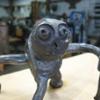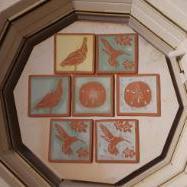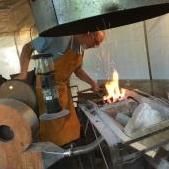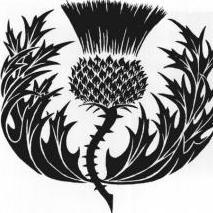-
Posts
521 -
Joined
-
Last visited
Contact Methods
-
MSN
kjjansen@msn.com
-
Website URL
http://www.butchercreekforge.com
Profile Information
-
Gender
Male
-
Location
Moscow Mills MO
Recent Profile Visitors
-

50 lb Little Giant brake pad?
MOblacksmith0530 replied to SoCal Dave's topic in Power Hammers, Treadle Hammers, Olivers
Talk to Phil (peacock). His bands are leather sewn to nylon. The nylon goes on the outside and acts as a spring so when the hammer it working it opens and has no drag. I can do single blows with my 50 using this brake system. -

St. Louis area smiths, classes
MOblacksmith0530 replied to biocmp's topic in Blacksmithing, General Discussion
I am about an hour northwest of St Louis in Lincoln county and if you want to come out and see my shop you are wellcome. I will be home later this week and during the weekend. PM me if you are interested. -
Kenny O I would forge weld up a piece of the cable and water quench and see if it cracks that will give you some good info. I have made a lot of cable knives. I like at least 5/8 diameter so I don't have to fold it for more mass. If you fold it a lot of the time the pattern gets too fine for what I like, I have had some 3/4 cable that wouldn't harden much in oil but got hard in water so to me that makes it medium carbon at best.
-
Mad rabbit If you have worked steel you have worked carbon steel. Steel is an alloy of iron and carbon at the very minimum, it may have other alloying elements but it is still an alloy in its very basic form. We blacksmiths like low carbon for general forging because the carbon is so low it won't appreciably harden. Modern "mild" steel is A-36 which tends to have more carbon in it as well as other trash. They now look at the tensil strength when it comes from the mill and little else.4140 tends to be in the medium carbon range and if memory serves it has cromium and molybdenum as its main alloying elements besides carbon. It will have .4 percent carbon plus or minus .05 percent I think. Here are some quick links on spark testing there are many http://en.wikipedia.org/wiki/Spark_testing http://www.scrapmetaljunkie.com/241/the-spark-test-and-spark-testing-metals-2
-
I sell forged russian or wrapped roses for 45. The roses from flat pattern steel for 30 due to the forging.and cost of the time to make the pieces from flat iron.
-
You need to start off by learning the basics, Some simple tools are possible with the very basics but not a lot. You need to learn to draw and taper, upset, bend, twist, punch, slit, drift, cut, Weld etc. A goo place to start is to make some simple s or c hooks. Draw the stock down to a nice even taper. Then bend it around the horn of an anvil or other device, twist it to make a c or s hook. You can't do anything until you learn some basic blacksmith skills. For example you mentioned tongs. A pair of tongs will require drawing and tapering, bending punching, drifting, upsetting and possibly some twisting. My suggestion is get a piece of metal hit and hit it with a hammer on your anvil and observe what it does. See what effect different typed of hits have and what they cause the metal to do.
-

Stupid Spectator Tricks
MOblacksmith0530 replied to T-Gold's topic in Blacksmithing, General Discussion
My favorite is the is that fire real usually by an older person say 60's or 50's. I give them the cat caught with the Canary feather look and say no it is one of those fireplace tinsel and fan things from the old fake fireplaces. Then I pull a hot piece of metal from the fire and forge it, they usually leave right after that. Although I did have one ask me how I got the metal hot then. -

Blu Max 110 Power hammer review
MOblacksmith0530 replied to AtelierKarabos's topic in Power Hammers, Treadle Hammers, Olivers
I had an issue with one of their hand hammers a few years back the replacement was perfect. I have not used one of their hammers for more than a few minutes. They seem to work fine but use a lot of air.- 11 replies
-
- Power Hammers
- Blue Max 110
-
(and 3 more)
Tagged with:
-

Is this a hammer Die?
MOblacksmith0530 replied to divermike's topic in Power Hammers, Treadle Hammers, Olivers
Spare tire hammer or treadle hammers both use dies like that. My spare tire hammer has a square plate the die is welded to with 4 holes. -
I have an un named air hammer I bought from Tom Clark it is like a 115lb version of your 33. I don't have any real issues in cold weather although it does not hit it's hardest until it warms up. If mine is running hard for 8 or 10 hours it gets a little sticky and hits uneven. Glad to hear yours is loosening up. I would like to have one of those little 33's they are nice hammers.
-
I picked up a 4" leg vise. It is missing a spring, which I will make and the wedge for the retainer is missing I will also make this have done both many times. I want to square the jaws and hopefully without having to do like the last few and put the whole thing in the forge and square the arms. I haven't even looked at it very closely to see what is bent or crooked. If any of you guys have a sure fire way to do the checkout and squaring I am open to new methods. When I get it straightened up it will be available for some new smiths around here at cost.
-

looking for a first anvil
MOblacksmith0530 replied to luckyth13teen's topic in Anvils, Swage Blocks, and Mandrels
Well the guy who is selling the Vulcan (second anvil) is a liar Vulcans don't ring they thud. They have a cast iron body with a "thin" tool steel face. The english pattern anvil would be worth between 2 and 2.50 a pound around here. -

Show me your Bottle Openers!
MOblacksmith0530 replied to Arbalist's topic in Blacksmithing, General Discussion
So it is wrought iron just fold it back on itself reweld it to another lump and do it again. You might weld it a couple of times to be sure it stays clean but wrought welds so east it is almost a sin. I have done several axes out of wrought and sooner ot later I try for a little too mugh at lower temps and crack it just get it up to heat and hammer it back together. You are then refining it to make it better wrought iron. -

Great Rivet Collection
MOblacksmith0530 replied to divermike's topic in Blacksmithing, General Discussion
Iron Dwarf 3/8 is a good size for tong rivets they have planty of strength. -
Sucker rod it is usually in the medium carbon range and you can make a nice light pair with plenty of strength.



